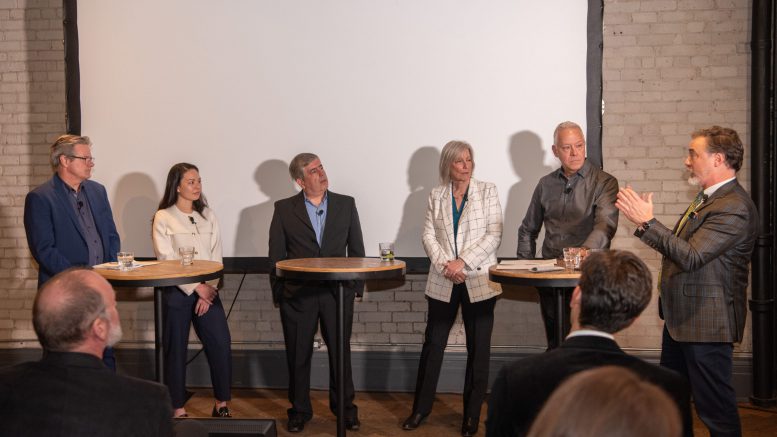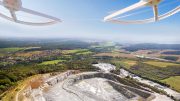Instead of reminiscing about the old times of hunting for minerals in the bush, miners need to talk up tech opportunities to attract young people to mining, industry panelists told an event in downtown Toronto on March 4.
Organized on the sidelines of the Prospectors and Developers Association of Canada convention by mining software company Seequent, a five-person panel discussed the challenge of achieving net zero mining, leveraging new technology, including artificial intelligence, and attracting new talent. Seequent develops earth modelling, geo-data management and team collaboration software for the mining, energy and engineering sectors.
Sally Goodman, vice-president of generative exploration with Newmont (TSX: NGT; NYSE: NEM) recalled attending a recent panel where geologists acknowledged the declining interest in geology programs, but then recounted the “good old days” of prospecting in the bush for weeks on end.

Seequent’s display site at the Prospectors and Developers Association of Canada convention in March. Credit: Seequent
“The industry isn’t listening,” she said. “Young people are turned off of those old stories. It doesn’t have to be done that way anymore at remote sites. If we can reduce the amount of time people are away from their families, that would help bring people back in.”
Poll data of young Canadians published in an October 2023 report by the Mining Industry Human Resources Council found the industry ranks lowest in a list of impressions across job sectors. Among 1,501 Canadians polled, 19% held a “positive” view of mining, 36% “neutral” and 20% “negative.” Although 65% believe mining jobs pay well, only 26% think the work is safe.
“We have to start listening to them,” panel moderator and Northern Miner Group president Anthony Vaccaro said.
Goodman also explained that the industry should try to promote remote technology applications because young people are already used to gaming with people around the world.
“We need to start making mining companies feel like tech companies,” said Shelby Yee, co-founder and CEO of mining technology firm Rockmass. “How can we combine those two worlds?”
Promise and peril of AI
Clever and efficient use of technology was a near-constant topic among the panelists, and Vaccaro asked them how artificial intelligence (AI) can be used for future exploration.
Goodman said that AI needs to be deployed to do the “grunt work” as it applies the concepts in the minds of geologists.
But AI’s possibilities also bring significant risk, such as with data security, said Marcelo Godoy, chief technology officer with AngloGold Ashanti (NYSE: AU).
“When AI engines start digesting large volumes of company data, there is a risk of confidential information being leaked,” he said. “It becomes critical to segregate information properly.”
Yee said mining companies should focus on low-risk, high-reward opportunities such as building up knowledge based on data, so that AI’s uses can be more manageable.
Faster, more remote
A good, rewarding place to start with data is speeding up the process of geological modelling, said Seequent CTO John Vandermay.
“The normal cycle of drilling and lab analytics, resource modelling and economics — that can take a whole year or so. That’s just not efficient,” he said. “We need to normalize that data and put it on the cloud and make it accessible.”
One challenging detail about exploration that demands specific solutions is that many mineral deposits tend to be deeper down and more covered than in previous years. AI must be able to correctly narrow down exploration targets, Godoy said.
Rob Ferguson, Seequent’s director of mineral exploration and resource management, said the COVID-19 pandemic helped unveil the possibilities of advanced technology. Being at a work site in-person is no longer always necessary, and cloud technologies can easily manage and transmit drilling data.
“(There can be) more use of drones, flying lower to the ground to help us find new deposits,” he said.
Reaching net zero
The panelists also discussed how meeting net zero milestones by 2050 will require new approaches of which the industry isn’t necessarily familiar.
“We think we know how to do things because that’s how we’ve always done them. We’re very risk averse,” said Goodman.
She explained that large mining companies have a lot of buying power and they should leverage that into innovative uses of technology that help reduce emissions.
“We can challenge the vendors that we work with about the next generation and what’s coming down the pipeline. We have to implement some of those technologies, knowing some of them will fail. That’s the only way we’ll help push the industry along,” she said.
Vaccaro then asked the panel just how more people can come to understand that, since the public sees mining as part of the problem of carbon emissions.
Godoy responded that mining critical minerals as a solution to carbon emissions is finally part of the conversation. And the industry is leading by example, with many of the largest companies committing to achieving net zero by 2050 and deploying electric or hybrid technologies at their sites. “Now we have whole groups looking at solutions at every single project we have, whether it’s wind farms or solar or micro grids,” he said.






Be the first to comment on "Show the public that minerals, tech are solutions for net zero: Seequent panel"